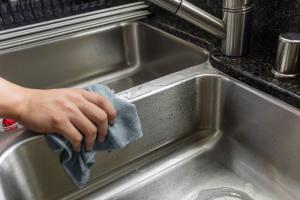Ultimate Guide: How to Remove Scratches from Your Stainless Steel Sink

-
Quick Links:
- Introduction
- Understanding Stainless Steel
- Common Causes of Scratches
- Tools and Materials Needed
- Step-by-Step Methods to Remove Scratches
- Preventing Future Scratches
- Case Studies
- Expert Insights
- Conclusion
- FAQs
Introduction
Stainless steel sinks are a popular choice in kitchens due to their durability and modern aesthetic. However, they can be prone to scratches, which can detract from their appearance. In this ultimate guide, we will explore the best methods to remove scratches from your stainless steel sink, ensuring it remains a stunning centerpiece in your kitchen for years to come.
Understanding Stainless Steel
Stainless steel is an alloy that contains chromium, which provides resistance to corrosion and rust. Its reflective surface is not only appealing but also functional, as it can withstand high temperatures and is easy to clean. However, it is not impervious to scratches, which can occur due to regular use.
Common Causes of Scratches
Understanding the causes of scratches can help you take preventive measures. Common sources of scratches include:
- Using abrasive cleaning tools
- Dragging pots and pans across the surface
- Cutting directly on the sink
- Improper installation of fixtures
Tools and Materials Needed
Before you begin removing scratches, gather the following tools and materials:
- Microfiber cloths
- Non-abrasive sponge
- Stainless steel cleaner
- Baking soda
- White vinegar
- Fine-grit sandpaper (320 to 600 grit)
- Polishing compound
- Protective gloves
- Masking tape
Step-by-Step Methods to Remove Scratches
Method 1: Using Baking Soda and Vinegar
This is a simple, effective method for light scratches. Follow these steps:
- Make a paste using baking soda and water.
- Apply the paste to the scratched area and gently rub with a non-abrasive sponge.
- Rinse thoroughly with water and dry with a microfiber cloth.
Method 2: Sandpaper Technique
For deeper scratches, sandpaper is an excellent option:
- Ensure the sink is clean and dry.
- Use masking tape to protect the surrounding areas.
- Wet the sandpaper and gently sand the scratch in the direction of the grain.
- Wipe away residue and check the scratch; repeat if necessary.
- Finish with a polishing compound to restore shine.
Method 3: Professional Stainless Steel Cleaners
If home methods don't yield results, consider using a commercial stainless steel cleaner:
- Follow the manufacturer's instructions on the product.
- Apply the cleaner to the scratched area and buff with a microfiber cloth.
Preventing Future Scratches
To keep your stainless steel sink looking pristine, consider these tips:
- Use cutting boards instead of cutting directly on the sink.
- Avoid dragging heavy pots and pans across the surface.
- Choose non-abrasive cleaning tools and products.
- Regularly clean and polish your sink to maintain its luster.
Case Studies
A homeowner named Sarah successfully removed scratches using the baking soda method. After sharing her experience on social media, she encouraged others to try it, leading to a community discussion on effective scratch-removal techniques.
Another case involved a kitchen renovation company that used sandpaper techniques on a heavily scratched sink. Their approach not only restored the sink but also enhanced the overall kitchen aesthetic, showcasing the importance of proper care and maintenance.
Expert Insights
According to home improvement expert Jane Doe, "Regular maintenance is crucial for stainless steel sinks. A little preventative care can go a long way in preserving their appearance."
Furthermore, leading cleaning specialists recommend using natural products like baking soda and vinegar as they are effective and eco-friendly.
Conclusion
Removing scratches from a stainless steel sink is achievable with the right techniques and tools. By following the methods outlined in this guide, you can restore your sink's shine and improve its longevity. Remember, prevention is key—maintaining your sink can minimize scratches and keep it looking new for years.
FAQs
1. Can all scratches be removed from a stainless steel sink?
Most light to moderate scratches can be removed with the methods described, but deeper scratches may require professional help.
2. Is sandpaper safe for stainless steel sinks?
Yes, when used correctly and in the direction of the grain, fine-grit sandpaper is safe for removing scratches.
3. What should I avoid when cleaning my stainless steel sink?
Avoid using abrasive sponges, steel wool, or harsh chemicals, as these can cause further scratches.
4. How often should I clean my stainless steel sink?
Regular cleaning is recommended, ideally after each use, to prevent build-up and scratches.
5. Can I use vinegar to clean my stainless steel sink?
Yes, vinegar is safe and effective for cleaning stainless steel, but it should be diluted with water.
6. How can I tell if my sink is too scratched to fix?
If the scratches are deep and you can feel them with your fingernail, it may be best to consult a professional.
7. What is the best way to maintain my stainless steel sink?
Regular cleaning with mild soap, using protective pads under pots, and avoiding harsh cleaners will help maintain your sink.
8. Can I use a magic eraser on my stainless steel sink?
Magic erasers can be used, but they may leave micro-scratches if used too aggressively; proceed with caution.
9. Is it worth buying a professional stainless steel cleaner?
Professional cleaners can be effective for tough stains and scratches, but many home remedies work just as well for regular maintenance.
10. What are the benefits of polishing my sink?
Polishing not only enhances the shine but also helps to protect the surface from scratches and staining.
Random Reads